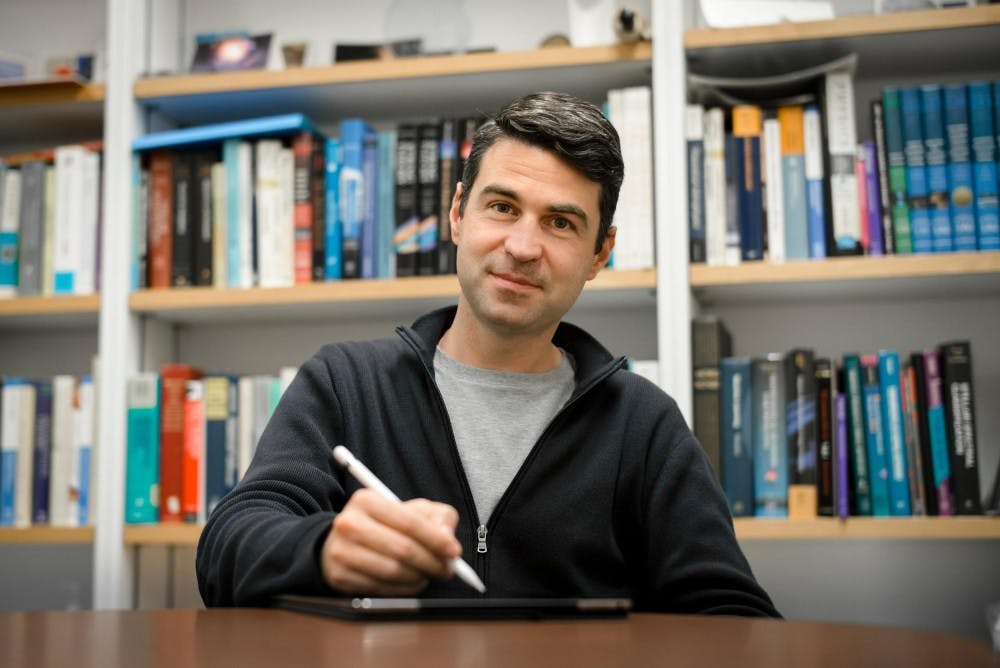Brice Ménard, an associate professor in the Department of Physics and Astronomy at Hopkins, will be speaking at the Hans Jensen Lecture at the University of Heidelberg in Germany on Oct. 10.
Ménard has been recognized as one of the leading researchers in astrophysics and its related fields. One of his recent accolades was the $250,000 President’s Frontier Award, which Ménard won in February.
The award recognized his discoveries of patterns and secrets in vast amounts of data, and it aims to provide more freedom and resources for such research projects.
His talk at the Hans Jensen lecture, titled “The Complexity Frontier,” will shed light on how researchers need to come up with new “languages” to make convoluted, newer ideas in science easier to understand.
Originally from France, Ménard completed his graduate studies at the Max Planck Institute for Astrophysics in Germany as well as the Institut d’Astrophysique de Paris. He joined Hopkins faculty in 2010.
At Hopkins, his research focuses on analyzing large astronomical data sets as well as exploring the mysterious properties of neural networks.
While some of this astronomical data has been available to other scientists for years, Ménard came up with new ways to analyze them.
Astrophysicists routinely encounter the challenge of analyzing large amounts of data to uncover hidden information.
According to Ménard, current scientific explorations do not always address the ways in which these complexities can be limiting.
As someone working at the edge of science and searching for hidden patterns in vast sets of data, he notes that there is only so much we can describe with equations that we can write down.
“Complexity is often what limits us in science — in many cases it is neither data nor computing power,” Ménard said in an interview with The News-Letter. “When things appear complex, it is often because we do not have the right language to describe them.”
Ménard suggested that searching for new patterns and analytical realizations that can allow scientists to glean a more foundational understanding from the ever-increasing amounts of information that they are collecting and processing.
As Ménard discerned, the brain does not use equations when making decisions. Science must pursue this higher-order processing, and science must also adapt to the processing through a renewed focus on finding languages that can describe the processes.
This pursuit of understanding the unknown is a fundamental aspect of science and is certainly a major motivation for the Hopkins physics and astronomy community. Hopkins is renowned for its research in diverse areas of science and humanities, and astrophysics fulfills that reputation. The combination of Hopkins resources and the nearby Space Telescope Science Institute makes Hopkins one of the largest concentrations of astrophysicists in the country.
“Everything in the universe is basically studied here,” Ménard added.
Owing to the vast resources for astrophysics and computational research at Hopkins, there also exists a multitude of opportunities for students who hope to contribute to such projects.
As is the case with a majority of the departments at Hopkins, Ménard points out that students can simply reach out and contact the faculty to join research projects.
For instance, Ménard has worked with undergraduates on the Hopkins Helium Balloon Project. The project sent balloons with sensors and cameras high up in the atmosphere to capture some phenomenal pictures of our blue planet. Reaching heights of over 85,000 feet, the balloon was a testament to the successful collaboration and problem-solving of the team of undergraduates who worked on the project.
The project focused on the physics, engineering and computer science of problem-solving and on producing a successful launch. The intersection of these disciplines made possible the accumulation of data and photos that are on the project’s website.
The Hans Jensen Lecture was named in honor of German nuclear physicist J. Hans D. Jensen, who won the Nobel Prize in Physics alongside American physicist Maria Goeppert Mayer in 1963 for their proposal of the nuclear shell model.
In addition to giving the Hans Jensen Lecture, Ménard will be discussing his research in the fields of astronomy and statistical physics at an upcoming presentation related to the President’s Frontier Award this semester.
The presentation will be open to anyone passionate about the innovative research taking place in those areas.





